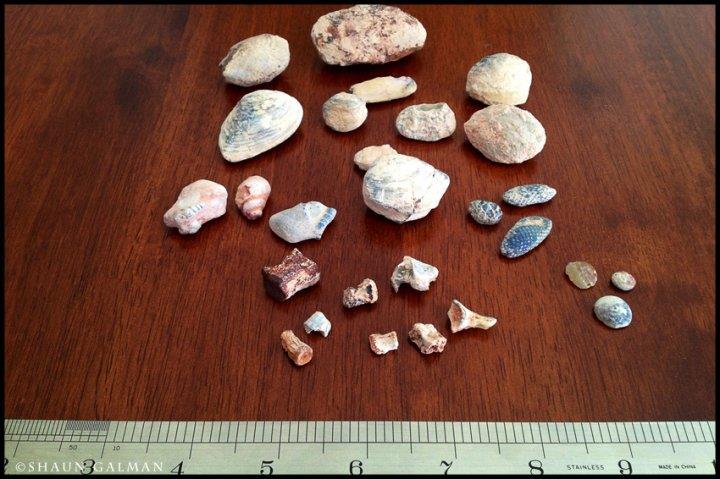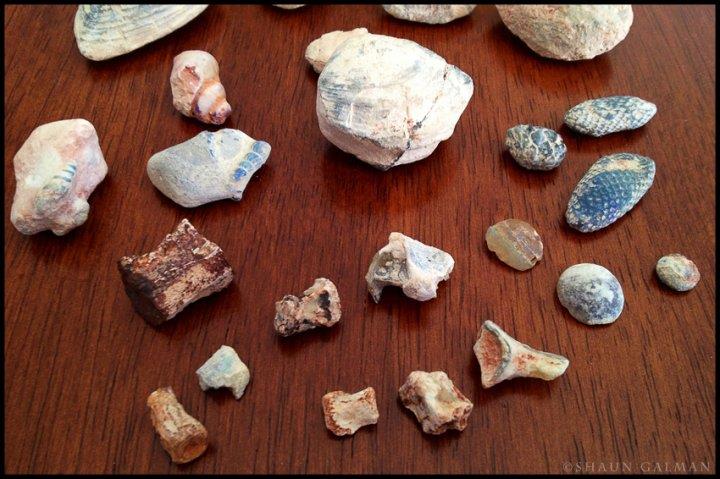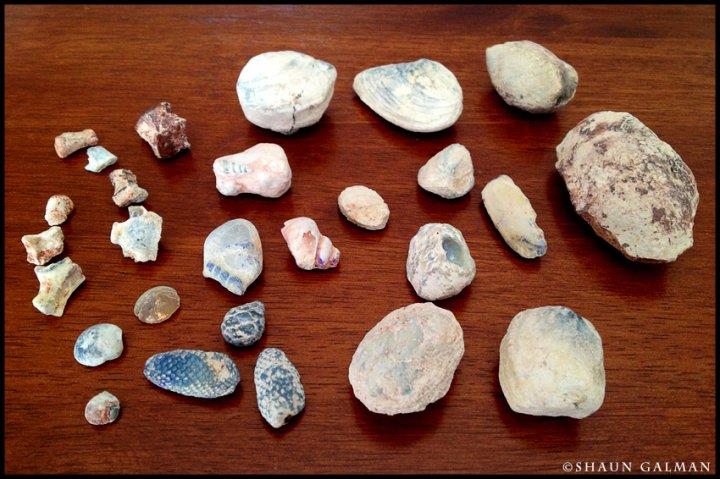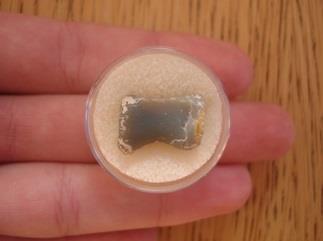Syndyne
Shaun Galman
Hi all,
Thought I'd share a small part of my collection of opalised fossil specimens that I've found around the fields over the last few years. I had built up quite a collection previously throughout the 90's, but had to regretfully sell it once the bad times set in on the opal -one of the unfortunate sides of mining. I had it looked at by the guys from the Australian Museum prior to make sure nothing was of importance before the sale. A part of that was a complete Plesiosaur tooth that I had dug from one of our better claims in 99. It was a beautiful specimen, mostly black-grey potch in make-up and no colour present but totally complete in structure. It measured about 3cm in length and had beautifully clean little striations running down the sides. I ended up getting $2800 for that single tooth.
These pieces are mostly the product of the Cretaceous Period and roughly 100million years in age. Many muscle shells here as they are fairly common on some fields. Three pine cones from an ancient relative of the current Conifer Pine species. Three small round "buttons" or Crayfish jaw plates. A couple small cone shells and a nice snail shell that I picked up late last year. Several bones and vertebrae from small mammals and some possible fish species which are the most important pieces here scientifically. These are also worth a small fortune to collectors.
The opal content, while nice is never worth the price of the fossil. Many, many people have destroyed top specimens and fossils trying to cut a stone from the opal content, not realising that sand and other inclusions are heavily present inside many pieces like these. Not only that but 99% of the time they have absolutely no clue what they are digging out.
It's always nice to come home with a new find. Sometimes it can be more exciting than finding a stone, particularly when you have a vested interest in Paleontology as we do
Couple quick iPhone snaps. I need to Reverse Macro some of these with my old Canon to offer a far better look. I'll get onto that.



As a side note while on fossils: Back in the late seventies, early eighties we amassed the worlds best collection of opalised fossils. A single part of this collection was one of the single most important fossil discoveries made in Australia. It was in the form of a small Monotreme Jawbone found by my father and uncle back in the early 80's. It came from the infamous Three Mile Fields and was called Steropodon galmani. The Steropodon was part of the Monotreme family and an early precursor to the modern Mammal species. It was a distant relative of the modern Platypus stemming from the Cretaceous Period.
The scientific importance of this piece came when they found the known Cretaceous Period origin was wrong. It was out by 20mill years (give or take) and made the find the very first Mesozoic Mammal fossil found in Australia.
Our entire collection was purchased by the Australian Museum in 1985 on the premise that the whole collection remain in Australia and not be sent overseas or split up. It's all still there locked away and still studied now and again I would imagine. I have had several VIP trips to the Museum since. Once we are there we are normally taken back into the offices and bombarded with questions about the finds. We spent quite some time with Prof. Alex Ritchie, Prof. Mike Archer and even Tim Flannery who was studying Mammals there at the time. To date it's been in thousands of separate publications worldwide, you may have even seen it on many of the fossil programs and documentaries on TV over time. If you have a fossil or Dinosaur book at home that covers Mammals or early Australian Dinosaurs you may just see it in there.
There's a really great little story that goes with the discovery that I will tell if I open a thread just on that fossil. You can Google it also. Just our little claim to fame
Kindest regards,
Shauno.
Thought I'd share a small part of my collection of opalised fossil specimens that I've found around the fields over the last few years. I had built up quite a collection previously throughout the 90's, but had to regretfully sell it once the bad times set in on the opal -one of the unfortunate sides of mining. I had it looked at by the guys from the Australian Museum prior to make sure nothing was of importance before the sale. A part of that was a complete Plesiosaur tooth that I had dug from one of our better claims in 99. It was a beautiful specimen, mostly black-grey potch in make-up and no colour present but totally complete in structure. It measured about 3cm in length and had beautifully clean little striations running down the sides. I ended up getting $2800 for that single tooth.
These pieces are mostly the product of the Cretaceous Period and roughly 100million years in age. Many muscle shells here as they are fairly common on some fields. Three pine cones from an ancient relative of the current Conifer Pine species. Three small round "buttons" or Crayfish jaw plates. A couple small cone shells and a nice snail shell that I picked up late last year. Several bones and vertebrae from small mammals and some possible fish species which are the most important pieces here scientifically. These are also worth a small fortune to collectors.
The opal content, while nice is never worth the price of the fossil. Many, many people have destroyed top specimens and fossils trying to cut a stone from the opal content, not realising that sand and other inclusions are heavily present inside many pieces like these. Not only that but 99% of the time they have absolutely no clue what they are digging out.
It's always nice to come home with a new find. Sometimes it can be more exciting than finding a stone, particularly when you have a vested interest in Paleontology as we do
Couple quick iPhone snaps. I need to Reverse Macro some of these with my old Canon to offer a far better look. I'll get onto that.



As a side note while on fossils: Back in the late seventies, early eighties we amassed the worlds best collection of opalised fossils. A single part of this collection was one of the single most important fossil discoveries made in Australia. It was in the form of a small Monotreme Jawbone found by my father and uncle back in the early 80's. It came from the infamous Three Mile Fields and was called Steropodon galmani. The Steropodon was part of the Monotreme family and an early precursor to the modern Mammal species. It was a distant relative of the modern Platypus stemming from the Cretaceous Period.
The scientific importance of this piece came when they found the known Cretaceous Period origin was wrong. It was out by 20mill years (give or take) and made the find the very first Mesozoic Mammal fossil found in Australia.
Our entire collection was purchased by the Australian Museum in 1985 on the premise that the whole collection remain in Australia and not be sent overseas or split up. It's all still there locked away and still studied now and again I would imagine. I have had several VIP trips to the Museum since. Once we are there we are normally taken back into the offices and bombarded with questions about the finds. We spent quite some time with Prof. Alex Ritchie, Prof. Mike Archer and even Tim Flannery who was studying Mammals there at the time. To date it's been in thousands of separate publications worldwide, you may have even seen it on many of the fossil programs and documentaries on TV over time. If you have a fossil or Dinosaur book at home that covers Mammals or early Australian Dinosaurs you may just see it in there.
There's a really great little story that goes with the discovery that I will tell if I open a thread just on that fossil. You can Google it also. Just our little claim to fame
Kindest regards,
Shauno.




